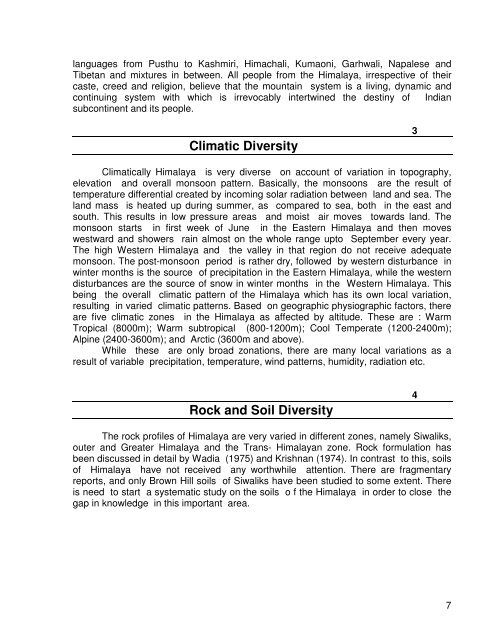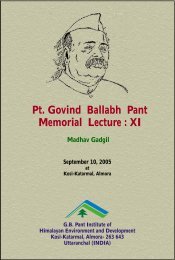Pandit Govind Ballabh Pant Memorial Lecture: II
Pandit Govind Ballabh Pant Memorial Lecture: II
Pandit Govind Ballabh Pant Memorial Lecture: II
Create successful ePaper yourself
Turn your PDF publications into a flip-book with our unique Google optimized e-Paper software.
languages from Pusthu to Kashmiri, Himachali, Kumaoni, Garhwali, Napalese and<br />
Tibetan and mixtures in between. All people from the Himalaya, irrespective of their<br />
caste, creed and religion, believe that the mountain system is a living, dynamic and<br />
continuing system with which is irrevocably intertwined the destiny of Indian<br />
subcontinent and its people.<br />
Climatic Diversity<br />
3<br />
Climatically Himalaya is very diverse on account of variation in topography,<br />
elevation and overall monsoon pattern. Basically, the monsoons are the result of<br />
temperature differential created by incoming solar radiation between land and sea. The<br />
land mass is heated up during summer, as compared to sea, both in the east and<br />
south. This results in low pressure areas and moist air moves towards land. The<br />
monsoon starts in first week of June in the Eastern Himalaya and then moves<br />
westward and showers rain almost on the whole range upto September every year.<br />
The high Western Himalaya and the valley in that region do not receive adequate<br />
monsoon. The post-monsoon period is rather dry, followed by western disturbance in<br />
winter months is the source of precipitation in the Eastern Himalaya, while the western<br />
disturbances are the source of snow in winter months in the Western Himalaya. This<br />
being the overall climatic pattern of the Himalaya which has its own local variation,<br />
resulting in varied climatic patterns. Based on geographic physiographic factors, there<br />
are five climatic zones in the Himalaya as affected by altitude. These are : Warm<br />
Tropical (8000m); Warm subtropical (800-1200m); Cool Temperate (1200-2400m);<br />
Alpine (2400-3600m); and Arctic (3600m and above).<br />
While these are only broad zonations, there are many local variations as a<br />
result of variable precipitation, temperature, wind patterns, humidity, radiation etc.<br />
Rock and Soil Diversity<br />
4<br />
The rock profiles of Himalaya are very varied in different zones, namely Siwaliks,<br />
outer and Greater Himalaya and the Trans- Himalayan zone. Rock formulation has<br />
been discussed in detail by Wadia (1975) and Krishnan (1974). In contrast to this, soils<br />
of Himalaya have not received any worthwhile attention. There are fragmentary<br />
reports, and only Brown Hill soils of Siwaliks have been studied to some extent. There<br />
is need to start a systematic study on the soils o f the Himalaya in order to close the<br />
gap in knowledge in this important area.<br />
7











